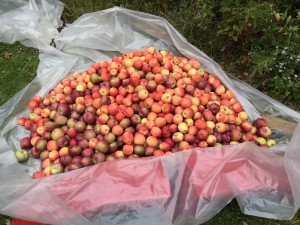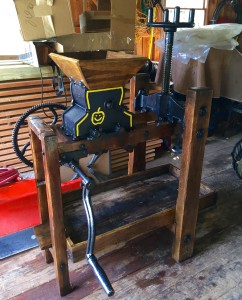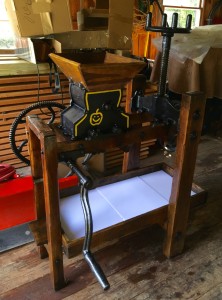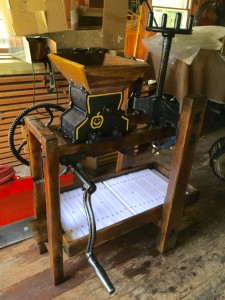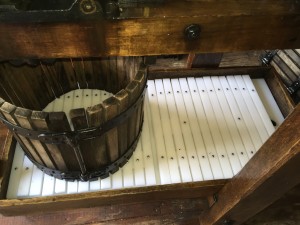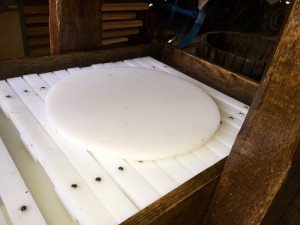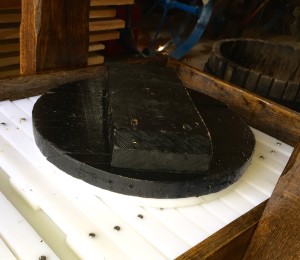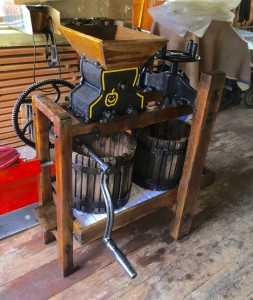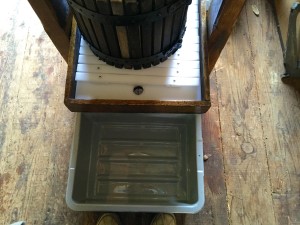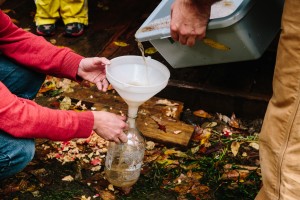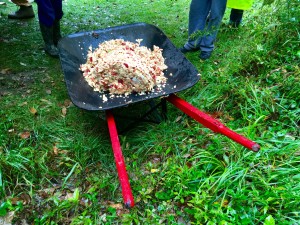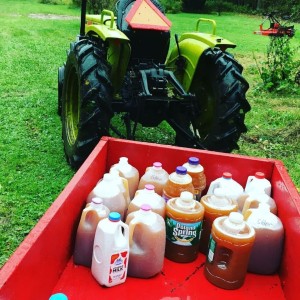Cider Press 101
Cider Press 101: We start with a clean apple blend in Western NY State. We use 40% Gala, 30% Cortland, and 30% MacIntosh. We also add ripe bartlett pears, if we can get them. It is important to completely clean the cider press and all its components, before starting to make apple cider.
The basic press which consists of an apple grinder/masher. The grinder consists of a coarse cylinder with raised cast iron knobs that grab and rip the apple apart. The apple is then thrown immediately into a two cylinder masher which crushes the apples into a wet pulp. The wet pulp falls into a tub lined with a sheet. When the tub is full it is slid on a rack and placed under the press. The press is a big screw with a flat base which is screwed down on a round hardwood block to press the apple juice out of the wet pulp. When the juice is pressed, the now dry pulp is discarded for compost.
We have made an effort to update our press by trying to reduce apple juice exposure to wood and instead use a cutting board material which is easier to wash, sanitize and keep clean. We have added a base of three sections of cutting board material. One section has a hole cut to allow the juice to flow out to be captured for bottling.
Next we add the sliding “Racks” which are basically slats to allow the juice to flow through the bottom when being pressed. Each tub and rack slides together as you move a tub of mashed apple pulp from underneath the grinder and move it underneath the press.
Again we have replaced the old wooden racks with new racks made from cutting board material and screwed together with stainless steel screws. We find these easy to clean. We line the tub with a common clean bedding sheet. Two sheets are needed; one for each tub. We line the tub with the sheet prior to filling with wet pulp. The edges of the sheet are left to hang outside the tub until the tub is full of wet pulp. The edges of the sheet are then used to cover the top of the tub to “seal the wet pulp in the tub. Then we slid it under the screw for pressing.
We have added a round base plate made of cutting board material which will be placed on top of the wet pulp before pressing.
We then add the original heavy hardwood base plate over the top of the white one made of cutting board material. Again, the base plate made out of cutting board material.
Now the cider press pieces are all in place like you would have them if your were ready to make cider.
There is a hole in the bottom of the tray to let the apple juice flow out to be bottled. We first catch it in a large clean plastic tray. We pour the cider out of the plastic tray into jugs using a funnel.
When we have a cider making party, the participants usually bring their own jugs to be filled with cider to take home with them. We usually say a toast when the first cider comes off the press and we all have a glass of fresh apple cider.
When we are done pressing a batch, we empty the sheet and the dry apple pulp comes out. We put this in a wheel barrow and put it in a pile for composting. It is important to completely wash and clean the press before putting it back in storage.
The last two years we captured about 24 gallons of apple cider from 12 bushels of apples. Commercial cider processors can yield about three gallons per bushel. Our jugs of fresh apple cider are ready to be taken home!!
